


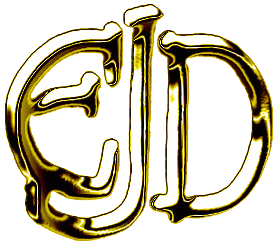 |
See issues 7 & 10 of
for Detmold art. |
|
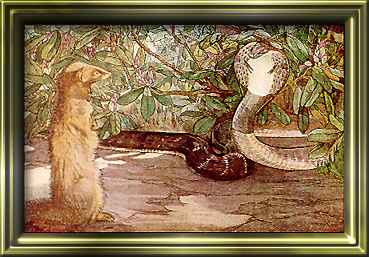
|
||
Edward Julius Detmold and his twin brother, Charles Maurice, were born in 1883. Others born within a year of them were John Bauer, Edmund Dulac, Harvey Dunn, Eric Gill, Walter Dean Goldbeck, Albert Hurter, Willy Pogany, Bert Thomas and N.C. Wyeth.
Born in London, they were tutored by an uncle who fostered their artistic talents and a love for natural history. Their animal subjects were always among the most sensitive of their drawings. Prodigious early talents, they exhibited watercolors at the Royal Academy when they were 13 and had a portfolio of etchings issued in 1898.
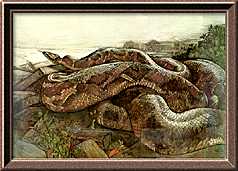 The brothers worked jointly on their etchings and illustrations. Their
first book illustrations were produced jointly for the 1899 Pictures
From Birdland. Their next project, at the ripe old age of
20, was a portfolio of 16 watercolors inspired by Kipling's The
Jungle Book. All of the plates are magnificent, but the one
that strikes me most deeply is the one at left by Maurice entitled
Kaa the Python. You can click the image at left
for a full-size scan. My favorite by Edward is at the top of this
page. All can be found in the 1908 Macmillan edition of The
Jungle Book.
The brothers worked jointly on their etchings and illustrations. Their
first book illustrations were produced jointly for the 1899 Pictures
From Birdland. Their next project, at the ripe old age of
20, was a portfolio of 16 watercolors inspired by Kipling's The
Jungle Book. All of the plates are magnificent, but the one
that strikes me most deeply is the one at left by Maurice entitled
Kaa the Python. You can click the image at left
for a full-size scan. My favorite by Edward is at the top of this
page. All can be found in the 1908 Macmillan edition of The
Jungle Book.
They were well on their way to joint and individual success when Maurice suddenly committed suicide in 1908. He was 24. No satisfactory explanation for the act has even been given. The coroner's inquest returned a verdict of suicide 'whilst unsound of mind' and there was apparently a note as well.

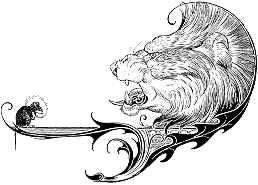 Edward was stunned by the sudden death of his twin, but managed to continue
on with his art. He lost himself in his work - etchings and drawings
and paintings; even colored block prints that I'd love to see.
Does anyone know if these survive?
Edward was stunned by the sudden death of his twin, but managed to continue
on with his art. He lost himself in his work - etchings and drawings
and paintings; even colored block prints that I'd love to see.
Does anyone know if these survive?
His next book illustrations practically defined him to his publishers and their patrons. These were the 1909 The Fables of Aesop for which he did 23 color plates and numerous pen & ink chapter heads. Samples of each at left and right. You can see many more of the color plates in David Larkin's The Fantastic Creatures of Edward Julius Detmold.
Then came Maurice Maeterlink's The Life of the Bee and Birds and Beasts and The Book of Baby Beasts in 1911. In 1912, it was the Book of Baby Birds and Hours of Gladness, which was released in the US as News of Spring (see the Venus Fly Trap image below). Animals and insects, insects and animals. It was obviously where his heart was. The renderings were from nature and as precise as any of the Pre-Raphaelites.
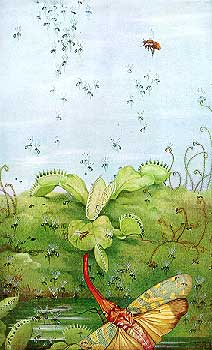
Other books had titles like The Book of Baby Pets and The Book of Baby Dogs (1915), Our Little Neighbors and Fabre's Book of Insects (1921) - all reflecting the natural history that had so fascinated him as a youngster. A perfect example is The Spanish Copris from Fabre, below.
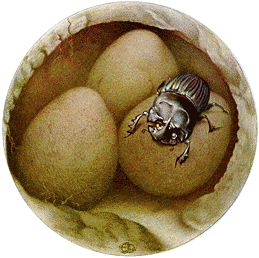
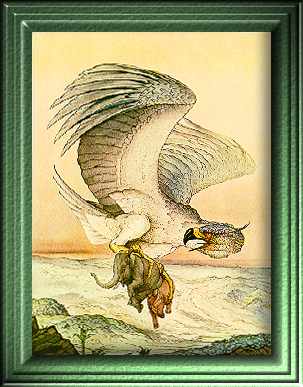
 Even when he branched out, as he theoretically did in 1924 with his
wonderful The Arabian Nights, he was just as likely to
choose animals to illustrate as he was to depict humans. Samples
of both are shown here.
Even when he branched out, as he theoretically did in 1924 with his
wonderful The Arabian Nights, he was just as likely to
choose animals to illustrate as he was to depict humans. Samples
of both are shown here.
It was to be his last illustrated work. In 1921 he had written a tract to attempt to explain himself, his work and his life. To quote from Keith Nicholson's introductory essay in The Fantastic Creatures of Edward Julius Detmold:
"A decade of intense activity was drawing to a close. Detmold could look back upon some fine achievements, but he was disillusioned with many of the uninspiring commissions for children's books he had undertaken. A pointless and destructive world war emphasized his worst forebodings of man's direction in the new century. The happiness of his childhood and the loss of his twin brother, now recollected in an uneasy tranquillity, combined to produce an existential crisis in the artist. In the wake of feeling that life for him had become meaningless and intolerable, he produced a literary work which testifies to his readings in Schopenhauerian pessimism and the Buddhist philosophy of the Upanishadr and the Bhagavad-Gita. Life, his only unillustrated work, a book of aphorisms, was published by J. M. Dent in 1921. A key book to an understanding of Detmold's mind, Life is an inauspicious-looking small volume printed on one side of the leaf only. In his preface the author writes: `The following words have come to the writer, over a period of many years, as the fruits of self-overcoming.' From the curious, mystical text we learn that there are two ways of attainment: `The direct positive way - through progressive liberation - passing from the lesser realization of the body, to the greater realization of the mind, and therefrom to the realization of the infinite through the soul; and the direct negative way -through disillusionment - which comes of infatuation with things in themselves, and the inevitable passing thereof.' In the event, Life was Detmold's farewell to the public world of books, and his testament.
"Resigned from the world, Detmold went to live in Montgomeryshire where, after a long retirement and almost totally forgotten, he died in July, 1957. Strangely, there exists no official record of his death."
I should note that Peppin and Micklethwait in Book Illustrators of the Twentieth Century, the most recent of the reference books I used, states that he, too, committed suicide. Alas.

The final image we've found from him is in the 1924 Penrose Annual. It's the lovely pair of hares above.
 To learn more about E.J. Detmold, see:
To learn more about E.J. Detmold, see:
| The Fantastic Kingdom | David Larkin, Ballantine 1974 |
| Fantasy The Golden Age of Fantastic Illustration | Brigid Peppin, Watson Guptill 1975 |
| The Fantastic Creatures of Edward Julius Detmold | David Larkin, Peacock Press/Bantam Books 1976 |
| The Dictionary of British Book Illustrators and Caricaturists 1800-1914 | Simon Houfe, Antique Collectors' Club 1981 |
| Book Illustrators of the Twentieth Century | Brigid Peppin & Lucy Micklethwait, Arco 1984 |
| The Vadeboncoeur Collection of Knowledge | Jim Vadeboncoeur, Jr. 2001 |
| The Vadeboncoeur Collection of ImageS 7, 10 | Jim Vadeboncoeur, Jr. 2003, 2008, JVJ Publishing |
|
Illustrations are copyright by their
respective owners. This page written, designed & © 2001 by Jim Vadeboncoeur, Jr. Updated 2011. |
